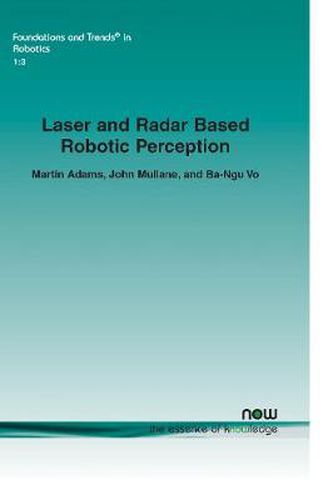Readings Newsletter
Become a Readings Member to make your shopping experience even easier.
Sign in or sign up for free!
You’re not far away from qualifying for FREE standard shipping within Australia
You’ve qualified for FREE standard shipping within Australia
The cart is loading…






This title is printed to order. This book may have been self-published. If so, we cannot guarantee the quality of the content. In the main most books will have gone through the editing process however some may not. We therefore suggest that you be aware of this before ordering this book. If in doubt check either the author or publisher’s details as we are unable to accept any returns unless they are faulty. Please contact us if you have any questions.
A crucial component of perception is the understanding of information which has passed through a sensor’s detection process. In the world of autonomous robotics this takes the form of sensor understanding and modelling, feature detection, predicting measurements/observations, feature matching and sensor data representation.
Laser and Radar Based Robotic Perception presents a review of autonomous robotic perception, exploring recent work from the autonomous robotics and tracking communities in general as well as from the authors’ own experiences. Throughout the text, experiments and results are derived from the authors’ experiences with laser and radar based sensors. The concepts used in the experiments, and conclusions drawn from them, are then compared with state of the art perception methods in a review type fashion.
The book also reviews and presents methods which cope probabilistically with missed detections (the possibility of a sensor not detecting an object of interest), object spatial uncertainty (in which detected objects are given uncertain range and/or bearing values due to sensor noise) and false alarms (the possibility of a sensor reporting a detection, due to noise, when in fact nothing (or nothing of interest) is present).
Environment measurement models based on these phenomena are therefore analysed. A further concept, often over-looked in the robotic, but apparent in the tracking literature, is that of estimating the correct number of features in an environment. Recent work which advocates the joint estimation of map features with respect to their number as well as location is reviewed.
$9.00 standard shipping within Australia
FREE standard shipping within Australia for orders over $100.00
Express & International shipping calculated at checkout
Stock availability can be subject to change without notice. We recommend calling the shop or contacting our online team to check availability of low stock items. Please see our Shopping Online page for more details.
This title is printed to order. This book may have been self-published. If so, we cannot guarantee the quality of the content. In the main most books will have gone through the editing process however some may not. We therefore suggest that you be aware of this before ordering this book. If in doubt check either the author or publisher’s details as we are unable to accept any returns unless they are faulty. Please contact us if you have any questions.
A crucial component of perception is the understanding of information which has passed through a sensor’s detection process. In the world of autonomous robotics this takes the form of sensor understanding and modelling, feature detection, predicting measurements/observations, feature matching and sensor data representation.
Laser and Radar Based Robotic Perception presents a review of autonomous robotic perception, exploring recent work from the autonomous robotics and tracking communities in general as well as from the authors’ own experiences. Throughout the text, experiments and results are derived from the authors’ experiences with laser and radar based sensors. The concepts used in the experiments, and conclusions drawn from them, are then compared with state of the art perception methods in a review type fashion.
The book also reviews and presents methods which cope probabilistically with missed detections (the possibility of a sensor not detecting an object of interest), object spatial uncertainty (in which detected objects are given uncertain range and/or bearing values due to sensor noise) and false alarms (the possibility of a sensor reporting a detection, due to noise, when in fact nothing (or nothing of interest) is present).
Environment measurement models based on these phenomena are therefore analysed. A further concept, often over-looked in the robotic, but apparent in the tracking literature, is that of estimating the correct number of features in an environment. Recent work which advocates the joint estimation of map features with respect to their number as well as location is reviewed.